Draft Energy Strategy and Just Transition Plan
We are consulting on this draft route map of actions we will take to deliver a flourishing net zero energy system that supplies affordable, resilient and clean energy to Scotland’s workers, households, communities and businesses.
Chapter 1: Our vision for a just transition to a net zero energy system
1.1 - Introduction
Our vision is that by 2045:
Scotland will have a flourishing, climate friendly energy system that delivers affordable, resilient and clean energy supplies for Scotland's households, communities and business. This will deliver maximum benefit for Scotland, enabling us to achieve our wider climate and environmental ambitions, drive the development of a wellbeing economy and deliver a just transition for our workers, businesses, communities and regions.
Scotland is an energy rich nation, benefitting from significant renewable energy resources the length and breadth of the country. We have a highly skilled workforce and innovative businesses across a globally renowned supply chain.
Scotland produces over 1,000 TWh of energy per year made up from oil and gas production, primary electricity, and bioenergy and waste (see figure 1)[8].
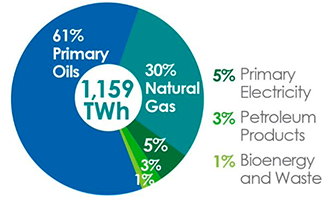
Source: Scottish Energy Statistics Hub
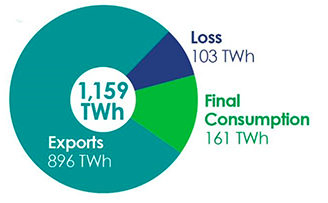
Source: Scottish Energy Statistics Hub
We export the vast majority of the energy we produce and our total consumption is approximately 161 TWh (see figure 2)[9]. Scotland's energy use can be broken down into requirements for heat, transport, electricity and other energy uses within sectors such as public administration, commercial and agriculture. Figure 3 shows how our energy use can be attributed to those sectors with heat accounting for around half of our requirements, and electricity and transport making up around a quarter. Figure 4 shows the fuels that make up the consumption of our energy. In the 2017 Scottish Energy Strategy, we set a target for the equivalent of 50% of the energy for Scotland's heat, transport and electricity to come from renewable sources by 2030. In 2020, renewable energy met around a quarter (26.7%) of the energy required for Scotland's heat, transport and electricity use.
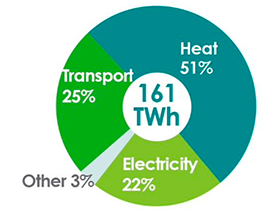
Source: Scottish Energy Statistics Hub
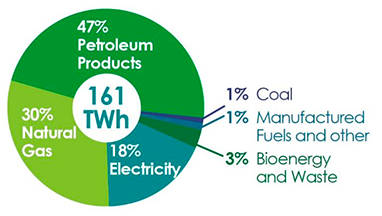
Source: Scottish Energy Statistics Hub
The volume of available renewable energy in Scotland continues to grow. Since 2000, Scotland has increased its renewable electricity capacity almost 10 times[10] and the current pipeline could more than double capacity. Looking ahead to 2045, this could increase further (see figure 5).
The significant increase in installed capacity of renewable generation over the coming decade could mean Scotland's annual electricity generation is more than double Scotland's electricity demand by 2030, and more than treble by 2045.
For example, ScotWind, the world's largest floating offshore leasing round, represents a massive step forward in delivering an energy revolution with market ambitions to deliver up to 27.6 GW of capacity - more than double our renewable energy generation capacity currently in operation[11].
This is in addition to almost 2 GW of existing operational projects, a 3.8 GW pipeline of projects consented or under construction, 4.2 GW of projects with lease options ahead of ScotWind leasing results, as well as INTOG[12] – a new leasing round designed to enable development of a potential further 5.7 GW of new offshore wind projects targeting oil and gas decarbonisation, plus further potential 0.5 GW of offshore wind innovation projects. This means that, subject to planning and consenting decisions and finding a route to market, we have a current reported potential pipeline (subject to change) of over 40 GW[13] of offshore wind projects – the equivalent to producing enough electricity annually to power every home in Scotland for 17 years or every home in the UK for over a year and a half.[14] This growth in renewables will enable Scotland to meet a large proportion of demand through renewables alone, while creating an export opportunity for our surplus[15] - see figure 6.
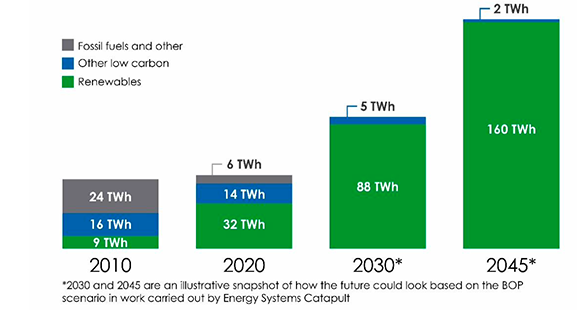
Source: Scottish Energy Statistics Hub and Scottish whole energy system scenarios
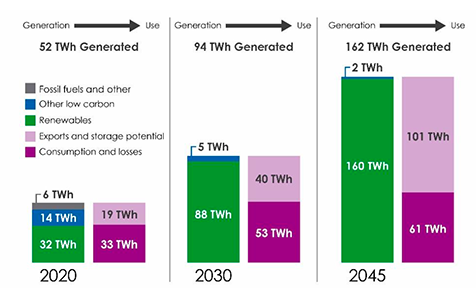
Source: Scottish Government
The majority of Scotland's greenhouse gas emissions come from our energy system (79%) but since 1990 total emissions have reduced by half, with energy supply making the largest reduction in emissions (see figure 7).
With increasing levels of renewable electricity and the closure of coal fired power stations in Scotland, the CO2 intensity of the electricity system has reduced by 90%[16]. By 2030, Scotland must reduce its overall emissions by 75%, as compared to 2019 levels, and 90% reduction by 2040.
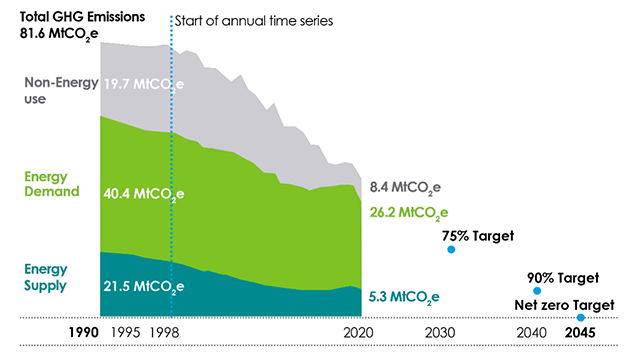
Source: Scottish Government
To ensure this happens, in addition to building our renewable capacity, we also now need to focus significant efforts on decarbonising energy for heat, transport and industry, on reforming markets to ensure energy security and affordability, and on maximising the benefits from the transition to net zero for our economy and our communities. The opportunities that creates are immense.
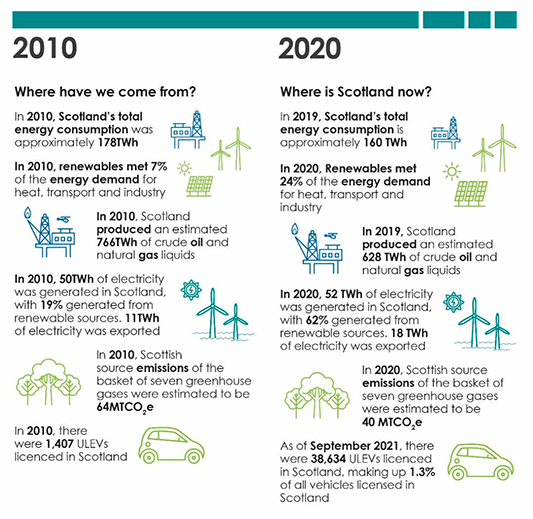
Source: Scottish Government / Scottish Statistics Hub / EY
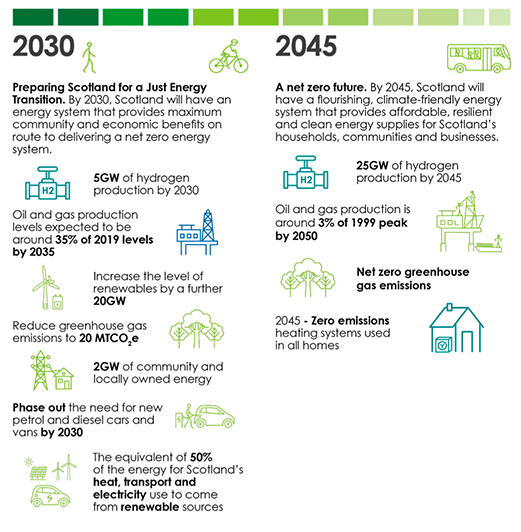
Source: Scottish Government / Scottish Statistics Hub / EY
1.2 - Delivering the vision
Chapter 2: Preparing Scotland for a Just Energy Transition
By 2030, Scotland will have an energy system that provides maximum community and economic benefits. We will have seen investment in green energy that delivers economic opportunities. Workers will have the training, skills and opportunities to access the good, green jobs that come with this. The energy market will be fairer, and costs will be distributed equitably. Home-grown clean energy provision will be maximised, limiting our exposure to the effects of global energy price shocks.
Chapter 3: Scotland will be a renewable powerhouse
By 2030, domestic production of renewable electricity and renewable hydrogen will have increased significantly, helping to address climate change by substantially reducing the emissions of our energy sector. By 2030, the total electricity produced in Scotland over the course of a year will allow us to continue to benefit from exporting electricity and open up the huge opportunities of vast renewable hydrogen production for use in Scotland and for export. This will contribute to economic growth, jobs and investment.
Scotland will be a renewable powerhouse, exporting renewable hydrogen and electricity to support decarbonisation in Europe as part of an integrated system with the rest of Europe. There will be an additional 20 GW of renewable electricity capacity and 5 GW hydrogen production, as well as substantial growth in marine and solar capacity. Oil and gas in the North Sea is becoming less plentiful and harder to extract. There will be no nuclear power, coal extraction or use of unconventional oil and gas or exploration of onshore conventional oil and gas.
Chapter 4 : Our future energy use will be climate friendly
By 2030, Scotland's main energy-using sectors - heat in buildings, transport, industry and agriculture - will be using energy more efficiently, and the energy they do use will be largely decarbonised, helping to deliver against our economy-wide statutory climate change targets. We will see significantly reduced demand for energy overall and at least 1 million homes decarbonised. Car kilometres will have reduced by 20% and Carbon Capture Utilisation and Storage will be on its way to being an established technology in Scotland. At least the equivalent of 50% of our energy across heat, transport and electricity demand will come from renewable sources. By 2032, industrial emissions will have decreased 43% from 2018 levels, and industry remains globally competitive.
Chapter 5: Creating the conditions for a net zero energy system
By 2030, Scotland's energy supplies will be secure, reliable and affordable for people and businesses across the country. The total electricity produced in Scotland will contribute to increasing energy security and limit the impacts of global energy shocks.
Maximising benefits to climate and the environment
By 2030, we will significantly increase domestic production of renewable electricity and hydrogen, and our energy use will be largely decarbonised. The transformation of Scotland's energy system will help us to achieve our net zero and interim climate targets. Our biodiversity, habitats and natural environment will have been protected and enhanced as part of the energy transition.
Maximising benefits to our economy, businesses and workers
By 2030, Scotland's energy sector will have net positive employment in a range of zero carbon industries. The net zero energy sector will continue to be a key driver of Scotland's economy in terms of gross value added (GVA), trade, supply chains, investment and prosperous businesses. The sector will be innovative and competitive, will attract investment to Scotland and will enable businesses to set up and grow sustainably. By 2030 the volume of renewable electricity produced in Scotland will open up huge opportunities for electricity export, and vast renewable hydrogen production for use in Scotland and for export, contributing to economic growth, jobs and investment.
Maximising benefits to our communities and regions
By 2030, regions and communities will be empowered to participate in the energy transition in a way that meets their needs including increasing the number of community owned energy projects. By 2030, the costs and benefits of the growth in our clean electricity generation will be shared equitably across society. By 2030, regions across Scotland will have thriving local energy economies. Scotland's energy sectors will provide fair work that recognises equalities, respect, voice and pay, and will create opportunities for local energy employment with a focus on supporting opportunities in vulnerable and deprived places and communities.
In developing the vision set out in this draft Strategy, we have drawn on insights from industry and communities, academia, civil society, as well as from research. In order to inform our understanding of Scotland's possible energy futures, we commissioned a series of energy scenarios that represent different pathways to a fair and affordable net zero energy system. These scenarios are explained in detail in Annex D and have helped inform our vision and the steps we will take to achieve it.
To achieve this vision, we will:
- Significantly scale up renewable energy production, including on- and offshore wind power, renewable hydrogen, marine energy, solar and hydro
- Increase access to affordable energy by urging the UK Government to take stronger and more targeted action for fair energy market reform, and by continuing to support those most in need to reduce their energy costs.
- Maximise community benefit from energy projects, including through community ownership and shared ownership of renewables.
- Continue to invest in the net zero energy economy and provide certainty through clear market signals to attract increased private investment.
- Increase support for skills development to help workers to play their full part in Scotland's transition to net zero.
- Boost our domestic supply chain and realise international opportunities through the expansion of our Supply Chain Development Programme and our support for export of low carbon energy goods and services.
- Set out finalised policy positions on fossil fuel energy, such as onshore conventional and unconventional oil and gas, offshore oil and gas, and coal, as well as nuclear.
- Continue to support the fastest possible just transition for the sector, including through the Energy Transition Fund and Just Transition Fund.
- Reduce demand and decarbonise our energy use across the heat and transport sectors, including taking actions to enable rapid decarbonisation of buildings through our Home Energy Scotland, Businesses Energy Scotland and Warmer Homes Scotland support schemes.
- Provide access to support to change how we heat, and use energy in, our homes through our new national public energy agency – Heat and Energy Efficiency Scotland.
- Support the switch to low and zero emissions vehicles through targeted investment in public transport and EV charging infrastructure.
- Support industry through the Scottish Industrial Energy Transformation Fund, the Energy Transition Fund, and the Emissions Trading Scheme to reduce demand and decarbonise energy use, including support for low carbon manufacturing.
- Continue to build the evidence base for carbon capture and storage deployment in Scotland and explore the international opportunities afforded by Scotland's vast CO2 storage assets, although we will prioritise domestic hard-to-abate emissions.
- Support farmers and crofters to reduce demand and decarbonise energy use through a suite of support and advice services, such as the Farm Advisory Service.
- Press the UK Government and the Office of Gas and Electricity Markets (Ofgem) to drive energy market reforms, including on network charging and regulation, decoupling electricity prices from the cost of gas, and ensuring market mechanisms are in place to deliver our ambitions in areas such as hydro and marine energy.
- Ensure the energy transition supports Scotland's ambitions for restoring nature and reversing biodiversity loss, including through avoidance of negative impacts and promotion of nature-based solutions.
- Continue to deliver and develop the UK ETS in line with our ambitious net zero target through the UK ETS Authority (made up of Scottish Government, Welsh Government, UK Government and Northern Ireland Executive).
Details on these actions are set out in Chapters 2-5.
Achieving our vision will be a national endeavour and will require a collective effort from government and agencies at local and national levels, industry, the research and innovation sector, our communities and civil society.
1.3 - Bute House Agreement
The Bute House Agreement, which came into effect on 31 August 2021, is an agreement between the Scottish Government and the Scottish Green Party Parliamentary Group (SGP). The Bute House Agreement commits the Scottish Government and SGP to work collaboratively to build a greener, fairer, independent Scotland, in a spirit of cooperation and consensus building.
The draft Strategy and Plan builds on the commitments made in the Bute House Agreement in relation to delivery of our ambition for 8-12 GW of additional onshore wind by 2030, support for the growth of marine renewables and the offshore wind sectors, the setting of a vision for solar energy, a strengthened heat in buildings policy framework, and a 10 year Just Transition Fund.
This draft Strategy and Plan draws on the programme of work that we are undertaking, announced by the First Minister in 2021, to better understand our energy requirements as we transition to net zero. The draft Strategy and Plan sets out our support for the fastest possible just transition for the sector and consults on principles to underpin a robust climate compatibility checkpoint on which decisions for new production should be based. The final Strategy and Plan's position on oil and gas will take account of the consultation process and any additional analytical work undertaken.
While we do not have an entirely shared vision for the role of hydrogen and carbon capture, utilisation and storage across the whole economy, we recognise – albeit to different extents – that these technologies will play a part in a just transition. The Scottish Government remains supportive of these technologies as part of the energy transition and in particular it remains committed to supporting the delivery of the Acorn project. However, we agree that any strategy for deployment of these technologies must enable decarbonisation at pace and cannot be used to justify unsustainable levels of fossil fuel extraction or impede Scotland's just transition to net zero.
1.4 - Action the UK Government must take
To deliver this Strategy and Plan we need action from the UK Government across a large number of reserved policy areas (summarised in Annex B), and in particular:
- energy affordability
- electricity market reform
- support for CCUS in Scotland
- support for the renewable electricity and hydrogen sectors through the continuation of existing, and introduction of new, market mechanisms that are fit for purpose, enable the necessary growth in scale and provide energy security
- extension of the powers of the Scottish Parliament in certain reserved areas, such as consenting and the offshore marine environment
- unlocking of mechanisms to allow communities to benefit directly from local renewable developments
- use of available powers to support international trade in renewables and renewable hydrogen
- reform of the climate compatibility checkpoint so that consent is only given for exploration or new production that is consistent with our international climate commitments and demonstrates clear economic and social benefit
- provide more support directly to the decommissioning sector to ensure as much of this growing area of work as possible is carried out in Scotland, creating and protecting jobs and economic opportunities.
These actions are set out in the relevant Chapters of this draft Strategy and summarised in Chapter 7.
Contact
Email: energystrategy@gov.scot
There is a problem
Thanks for your feedback